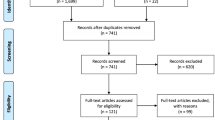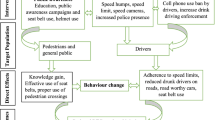Abstract
OBJECTIVES: Motor vehicle crashes (MVCs) are a leading cause of death for Canadian Aboriginal peoples; developing effective interventions should be a public health priority. While intervention research has been conducted outside of Canada, few formal program evaluations have been conducted in Canada. We reviewed Canadian and non-Canadian Indigenous road safety initiatives to inform future program development in Canada.
METHODS: A systematic review of the published and grey literature examining MVC intervention programs in Indigenous communities was performed. Studies published after 1980 reporting pre-post comparisons of MVC interventions in Indigenous communities were included in the review. These studies were assessed using a modified Participatory Action Research quality assessment tool. Haddon’s Matrix of injury epidemiology and prevention was used to categorize crash-related risk factors targeted in the MVC interventions.
SYNTHESIS: A total of 11 studies met inclusion criteria, including 1 Canadian study and 10 non-Canadian studies. Successful intervention components included focus groups, training community members, educational activities, distribution of safety devices, collaboration with local law officials to enhance enforcement, driver-licensing courses, and incentive programs. Potential barriers to successful implementation and evaluation involved lack of incorporation of cultural and contextual factors, enforcement factors, and methodological limitations.
CONCLUSION: Several effective strategies to reduce MVCs can be adapted and implemented at the community and national levels. Future directions might include using multiple intervention components and incorporating a collaborative, culturally and contextually appropriate approach, while promoting evaluation initiatives and widespread dissemination of findings.
Résumé
OBJECTIFS : Les accidents d’automobile sont l’une des principales causes de mortalité pour les Autochtones du Canada; élaborer des interventions efficaces devrait donc être une priorité pour la santé publique. On effectue de la recherche d’intervention hors du Canada, mais on mène peu d’évaluations formelles des programmes canadiens. Nous avons examiné des initiatives canadiennes et non canadiennes de sécurité routière indigène afin d’éclairer l’élaboration future de programmes au Canada.
MÉTHODE: Nous avons mené une revue systématique de la littérature publiée et de la littérature grise portant sur les programmes de prévention des accidents d’automobile dans les communautés indigènes. Nous avons inclus dans cette revue les études publiées après 1980 établissant des comparaisons pré/post des interventions portant sur les accidents d’automobile dans les communautés indigènes. Ces études ont été évaluées à l’aide d’un outil modifié d’évaluation de la qualité de la recherche-action. La matrice de Haddon appliquée à l’épidémiologie et à la prévention des blessures a servi à catégoriser les facteurs de risque d’accident ciblés par les interventions portant sur les accidents d’automobile.
SYNTHÈSE: En tout, 11 études ont répondu à nos critères d’inclusion, dont une étude canadienne et 10 études non canadiennes. Les éléments des interventions fructueuses étaient les groupes de discussion, la formation des membres de la communauté, les activités éducatives, la distribution de dispositifs de sécurité, la collaboration avec les agents locaux de la force publique pour améliorer l’application de la loi, les cours d’obtention du permis de conduire et les programmes d’incitation. Les obstacles possibles à la mise en oeuvre fructueuse et à l’évaluation étaient le manque d’intégration des facteurs culturels et contextuels, les facteurs d’application de la loi et les contraintes méthodologiques.
CONCLUSION: Plusieurs stratégies de réduction des accidents d’automobile efficaces peuvent être adaptées et mises en oeuvre à l’échelle communautaire et nationale. Les orientations futures peuvent inclure l’utilisation d’outils d’intervention multiples et l’intégration d’une approche concertée, appropriée sur les plans culturel et contextuel, tout en favorisant les initiatives d’évaluation et la diffusion généralisée des constatations.
Similar content being viewed by others
References
Short MM, Mushquash CJ, Bédard M. Motor vehicle crashes among Canadian Aboriginal peoples: Identifying trends, gaps, and priorities in the research literature. Can J Rural Med 2013;18:86–98.
Desapriya E, Fujiwara T, Verma P, Babul S, Pike I. Comparison of on-reserve road versus off-reserve road motor vehicle crashes in Saskatchewan, Canada: A case control study. Asia Pac J Public Health 2011;23(6):1005–20.
Fantus D, Shah BR, Qiu F, Hux J, Rochon P. Injuries in First Nations communities in Ontario. Can J Public Health 2009;100(4):258–62.
Constitution Act, 1982, being Schedule B to the Canada Act 1982 (UK), 1982, c 11.
MacFarlene P. Injury prevention: New approaches to injury prevention. In Touch 1997;7:1–27.
Haddon W. A logical framework for categorizing highway safety phenomena and activity. J Trauma 1972;12:193–207.
Runyan, CW. Back to the future–revisiting Haddon’s conceptualization of injury epidemiology and prevention. Epidemiol Rev 2003;25:60–64.
Christoffel T, Gallagher, SS. Injury Prevention and Public Health: Practical Skills, Knowledge, and Strategies. Gaithersburg, MD: Aspen Publishers, 1999.
Higgins JPT, Green S. Cochrane Handbook for Systematic Reviews of Interventions, Version 5.1.0. (updated March 2011). The Cochrane Collaboration, 2011. Available at: http://www.cochrane-handbook.org (Accessed May 15, 2012).
Stroup DF, Berlin JA, Mortin SC, Olkin I, Williamson JD, Rennie D, et al. Metaanalysis of observational studies in epidemiology: A proposal for reporting. JAMA 2000;283:2008–12.
Saini M. A systematic review of Western and Aboriginal research designs: Assessing cross-validation to explore compatibility and convergence. Prince George, BC: National Collaborating Centre for Aboriginal Health, 2012.
Effective Public Health Practice Project, Canada. Quality Assessment Tool for Quantitative Studies Method (updated June 2009). Available at: http://www.hamilton.ca (Accessed April 10, 2014).
Castellano M. Ethics of Aboriginal research. J Aborig Health 2004;1:98–114.
Mercer SL, Green LW, Cargo M, Potter M, Daniel M, Olds S, et al. Appendix C: Reliability-tested guidelines for assessing participatory research projects. In: Minkler M, Wallerstein N (Eds.), Community-based Participatory Research for Health: From Process to Outcomes. San Francisco, CA: Jossey-Bass, 2008.
Transport Canada. Child Passenger Safety Promotion in Aboriginal Communities. Final Report. Ottawa, ON: Transport Canada, 2007.
John SL, Berger, LR. Yakama Nation initiatives to promote seat belt use. IHS Prim Care Provid 2001;26:168–69.
Letourneau RJ, Crump CE, Bowling JM, Kuklinski DM, Allen, CW. Ride safe: A child passenger safety program for American Indian/Alaska Native children. Matern Child Health J 2008;12 (suppl 1):S55–S63.
Letourneau RJ, Crump CE, Thunder N, Voss R. Increasing occupant restraint use among Ho-Chunk Nation members: Tailoring evidence-based strategies to local context. IHS Prim Care Provid 2009;34:212–18.
Phelan KJ, Khoury J, Grossman DC, Hu D, Wallace LJD, Bill N, et al. Pediatric motor vehicle related injuries in the Navajo Nation: The impact of the 1988 child occupant restraint laws. Inj Prev 2002;8:216–20.
Reede C, Piontkowksi S, Tsatoke G. Using evidence-based strategies to reduce motor vehicle injuries on the San Carlos Apache Reservation. IHS Prim Care Provid 2007;32:209–12.
Robertson-Begay M, Bert B, Deal P, Bill, NM. Hardrock Chapter’s injury prevention program: Building tribal capacity in a rural Navajo community. IHS Prim Care Provid 2007;32:266–68.
Billie H, LaFramboise J, Tabbee B. Ute Indian tribe enforcement-based injury prevention program. IHS Prim Care Provid 2007;32:281–83.
Williams D. Buckle up for life: An incentive program. IHS Prim Care Provid 1998:23;75–77.
Brewin M, Coggan C. Evaluation of the Ngati Porou community intervention project. Ethn Health 2004;9:5–15.
Russel-Weisz L. East Kimberley Aboriginal restraints & drink driving media campaign. Community Road Safety Grant Report. 2004.
Flicker S, Worthington, CA. Public health research involving Aboriginal peoples: Research ethics board stakeholders’ reflections on ethics principles and research processes. Can J Public Health 2012;103:19–22.
Author information
Authors and Affiliations
Corresponding author
Additional information
Acknowledgements: This project was funded through a Summer Internship Grant in Injury Prevention from the Ontario Neurotrauma Foundation.
Conflict of Interest: None to declare.
Rights and permissions
About this article
Cite this article
Short, M.M., Mushquash, C.J. & Bédard, M. Interventions for motor vehicle crashes among Indigenous communities: Strategies to inform Canadian initiatives. Can J Public Health 105, e296–e305 (2014). https://doi.org/10.17269/cjph.105.4176
Received:
Accepted:
Published:
Issue Date:
DOI: https://doi.org/10.17269/cjph.105.4176




